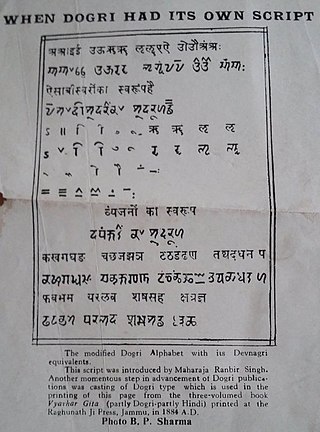Mathematical Alphanumeric Symbols is a Unicode block comprising styled forms of Latin and Greek letters and decimal digits that enable mathematicians to denote different notions with different letter styles. The letters in various fonts often have specific, fixed meanings in particular areas of mathematics. By providing uniformity over numerous mathematical articles and books, these conventions help to read mathematical formulas. These also may be used to differentiate between concepts that share a letter in a single problem.

The Cham script is a Brahmic abugida used to write Cham, an Austronesian language spoken by some 245,000 Chams in Vietnam and Cambodia. It is written horizontally left to right, just like other Brahmic abugidas.

Dogri is an Indo-Aryan language of the Western Pahari group, primarily spoken in the Jammu region of Jammu and Kashmir, India, with smaller groups of speakers in the adjoining regions of western Himachal Pradesh, northern Punjab, and north-eastern Pakistani Punjab. It is the ethnic language of the Dogras, and was spoken in the historical region of Duggar. It is currently spoken in the districts of Kathua, Jammu, Samba, Udhampur, and Reasi, Unusually for an Indo-European language, Dogri is tonal, a trait it shares with other Western Pahari languages and Punjabi. It has several varieties, all with greater than 80% lexical similarity.
In Unicode, a Private Use Area (PUA) is a range of code points that, by definition, will not be assigned characters by the Unicode Consortium. Three private use areas are defined: one in the Basic Multilingual Plane, and one each in, and nearly covering, planes 15 and 16. The code points in these areas cannot be considered as standardized characters in Unicode itself. They are intentionally left undefined so that third parties may define their own characters without conflicting with Unicode Consortium assignments. Under the Unicode Stability Policy, the Private Use Areas will remain allocated for that purpose in all future Unicode versions.

The Tākri script is an abugida writing system of the Brahmic family of scripts. It is derived from the Sharada script of Kashmiri language. It is the sister script of Laṇḍā scripts. It has another variant Dogra Takri employed in Jammu region. There are numerous varieties present throughout Punjab. Until the late 1940s, the adapted version of the script was the official script for writing Dogri in the princely state of Jammu and Kashmir. Throughout the history, different kingdoms of what now forms Himachal Pradesh used their own variety to maintain their records. The Takri script used in Sirmour in Himachal Pradesh and in the adjacent region of Jaunsar-Bawar in Uttarakhand has some distinction.
Specials is a short Unicode block of characters allocated at the very end of the Basic Multilingual Plane, at U+FFF0–FFFF. Of these 16 code points, five have been assigned since Unicode 3.0:
The Basic Latin Unicode block, sometimes informally called C0 Controls and Basic Latin, is the first block of the Unicode standard, and the only block which is encoded in one byte in UTF-8. The block contains all the letters and control codes of the ASCII encoding. It ranges from U+0000 to U+007F, contains 128 characters and includes the C0 controls, ASCII punctuation and symbols, ASCII digits, both the uppercase and lowercase of the English alphabet and a control character.
CJK Symbols and Punctuation is a Unicode block containing symbols and punctuation used for writing the Chinese, Japanese and Korean languages. It also contains one Chinese character.
Georgian is a Unicode block containing the Mkhedruli and Asomtavruli Georgian characters used to write Modern Georgian, Svan, and Mingrelian languages. Another lower case, Nuskhuri, is encoded in a separate Georgian Supplement block, which is used with the Asomtavruli to write the ecclesiastical Khutsuri Georgian script.
Gurmukhi is a Unicode block containing characters for the Punjabi language, in the Gurmukhi script. In its original incarnation, the code points U+0A02..U+0A4C were a direct copy of the Gurmukhi characters A2-EC from the 1988 ISCII standard. The Devanagari, Bengali, Gujarati, Oriya, Tamil, Telugu, Kannada, and Malayalam blocks were similarly all based on their ISCII encodings.
Gujarati is a Unicode block containing characters for writing the Gujarati language. In its original incarnation, the code points U+0A81..U+0AD0 were a direct copy of the Gujarati characters A1-F0 from the 1988 ISCII standard. The Devanagari, Bengali, Gurmukhi, Oriya, Tamil, Telugu, Kannada, and Malayalam blocks were similarly all based on their ISCII encodings.
Oriya is a Unicode block containing characters for the Odia, Khondi and Santali languages of the state of Odisha in India. In its original incarnation, the code points U+0B01..U+0B4D were a direct copy of the Odia characters A1-ED from the 1988 ISCII standard. The Devanagari, Bengali, Gurmukhi, Gujarati, Tamil, Telugu, Kannada, and Malayalam blocks were similarly all based on their ISCII encodings.
Cherokee is a Unicode block containing the syllabic characters for writing the Cherokee language. When Cherokee was first added to Unicode in version 3.0 it was treated as a unicameral alphabet, but in version 8.0 it was redefined as a bicameral script. The Cherokee block contains all the uppercase letters plus six lowercase letters. The Cherokee Supplement block, added in version 8.0, contains the rest of the lowercase letters. For backwards compatibility, the Unicode case folding algorithm—which usually converts a string to lowercase characters—maps Cherokee characters to uppercase.
Halfwidth and Fullwidth Forms is the name of a Unicode block U+FF00–FFEF, provided so that older encodings containing both halfwidth and fullwidth characters can have lossless translation to/from Unicode. It is the second-to-last block of the Basic Multilingual Plane, followed only by the short Specials block at U+FFF0–FFFF. Its block name in Unicode 1.0 was Halfwidth and Fullwidth Variants.
Phoenician is a Unicode block containing characters used across the Mediterranean world from the 12th century BCE to the 3rd century CE. The Phoenician alphabet was added to the Unicode Standard in July 2006 with the release of version 5.0. An alternative proposal to handle it as a font variation of Hebrew was turned down.
Adlam is a Unicode block containing characters from the Adlam script, an alphabetic script devised during the late 1980s for writing the Fula language in Guinea, Nigeria, Liberia, and other nearby countries.
Georgian Extended is a Unicode block containing Georgian Mtavruli letters that function as uppercase versions of their Mkhedruli counterparts in the Georgian block. Unlike all other casing scripts in Unicode, there is no title casing between Mkhedruli and Mtavruli letters, because Mtavruli is typically used only in all-caps text, although there have been some historical attempts at capitalization.
Makasar is a Unicode block containing characters for Makasar script . The script was used historically in South Sulawesi, Indonesia for writing the Makassarese language.

The Dogri script is a writing system originally used for writing the Dogri language in Jammu and Kashmir in the northern part of the Indian subcontinent.
Dogras, or Dogra people, are an Indo-Aryan ethnic community of Pakistan and India.




